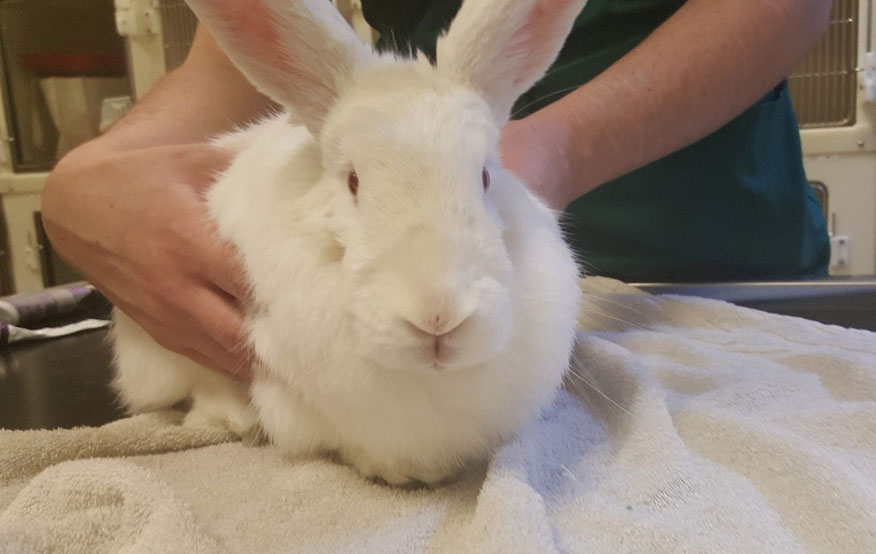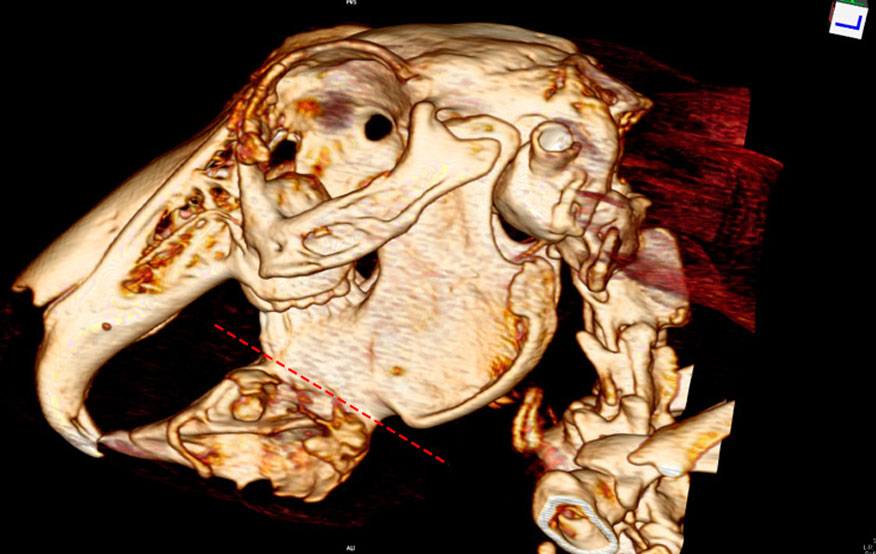Rabbit Partial Hemimandibulectomy at the Beaumont’s Exotics Service
Clinical Connections – Autumn 2016
Snowy, a three-year-old rabbit, was referred to the Exotics and Small Mammals Service at the RVC’s Beaumont Sainsbury Animal Hospital for assessment of an ongoing facial abscess.
Facial abscesses are commonly seen in pet rabbits and usually associated with underlying dental disease. Previous x-rays had indicated bony changes, which appeared to be involving the root of Snowy’s lower left incisor.

Initial medical and surgical treatment had not been able to resolve the problem and her owners were, therefore, keen to look at further options for treatment and so got her referred to the RVC team.
Snowy appeared bright during her first visit to the Exotics and Small Mammals Service and, apart from the firm mass on her left mandible, was otherwise in good health. She was sedated for a CT scan to investigate the extent of the problem.
The scan revealed an osteolytic and osteoproductive lesion affecting a large portion of the left rostral mandible, with marked soft tissue swelling surrounding this. The root of the lower left incisor was also confirmed to be involved.
The normal aim for abscess surgery in rabbits is to remove the entire abscess within its capsule, or as large an amount as is feasibly possible. With dental abscesses, it is also important to remove any associated teeth. The problem with Snowy, was that so much of the underlying bone was affected that just removing the visible pus at that stage would be very unlikely to completely treat her problem.
There RVC team, therefore, decided to perform a partial hemimandibulectomy on the affected side to ensure that all affected tissue was completely removed. This kind of procedure is not commonly performed in rabbits, due to concerns about possible complications with the remaining teeth (as rabbits need to be constantly eating and wearing down their teeth). However, as

already had dental problems, this seemed the best treatment option in her case.
Snowy coped extremely well with such a major surgery. She stayed in hospital for intensive supportive care from the vet and veterinary nursing team but by the next day she was already starting to show interest in her food and looking bright. She returned home on two days later, prescribed marbofloxacin and metronidazole for antibiotic cover while awaiting culture results and meloxicam for pain relief.
The operation was 10 months ago and Snowy has had regular dental check-ups. There has been no recurrence of her abscess and it would not be apparent, from looking at her, that she ever had any problems.
Commenting on the case, Exotics Service veterinary surgeon Nadene Stapleton, said: “Such extensive surgery is never undertaken lightly in any species. The added difficulties of pain assessment and management, as well as management of common post-operative states, such as anorexia and gut stasis, in prey species make them an even greater challenge.
“Prey species often require extensive post-operative nursing care from our dedicated exotics nursing team. However, Snowy surprised us all with her rapid recovery and willingness to eat post-operatively.”
She added: “We were delighted to be able to apply our expertise to achieve such a great outcome when for many such rabbits the only other alternative is euthanasia.”
The RVC’s Exotics and Small Mammals Service, which was established in 2014, is the only specialist exotics service in central London and the only full-time exotics service at an English veterinary school. The team treats a wide variety of species, including rabbits and other small mammals, reptiles, birds, amphibians, ornamental fish and invertebrates.
Sign up to get Clinical Connections in your inbox rvc.ac.uk/clinical-connections
